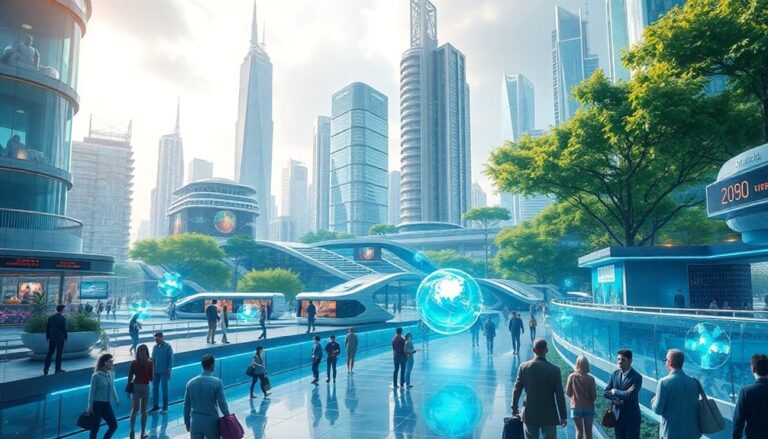In 2050, you'll see a world transformed by tech advancements and economic shifts. Emerging economies like India and Nigeria will thrive, while China dominates global GDP. AI will enhance healthcare and revolutionize daily life, with personalized systems tailored just for you. Renewable energy will make up nearly all of our electricity, drastically reducing fossil fuel use. Expect longer life expectancies and increased focus on mental health, changing societal norms. Public transport will thrive, making your commutes smoother and greener. Curious about how these changes will unfold? There's much more to explore about the future ahead!
Essential Insights
- The global economy is expected to grow to approximately $227.9 trillion, with emerging economies like China and India leading the growth.
- Renewable energy sources will supply 85-90% of global electricity, significantly reducing reliance on fossil fuels by 2050.
- Advances in AI and biotechnology will enhance personalized healthcare, revolutionizing treatment methods and disease management.
- Global life expectancy is projected to rise to 78.1 years, shifting the focus from communicable to chronic diseases due to an aging population.
- Public transport and shared mobility will dominate urban travel, with a projected increase in usage from 14.5% to 35% by 2050.
Economic Growth Projections
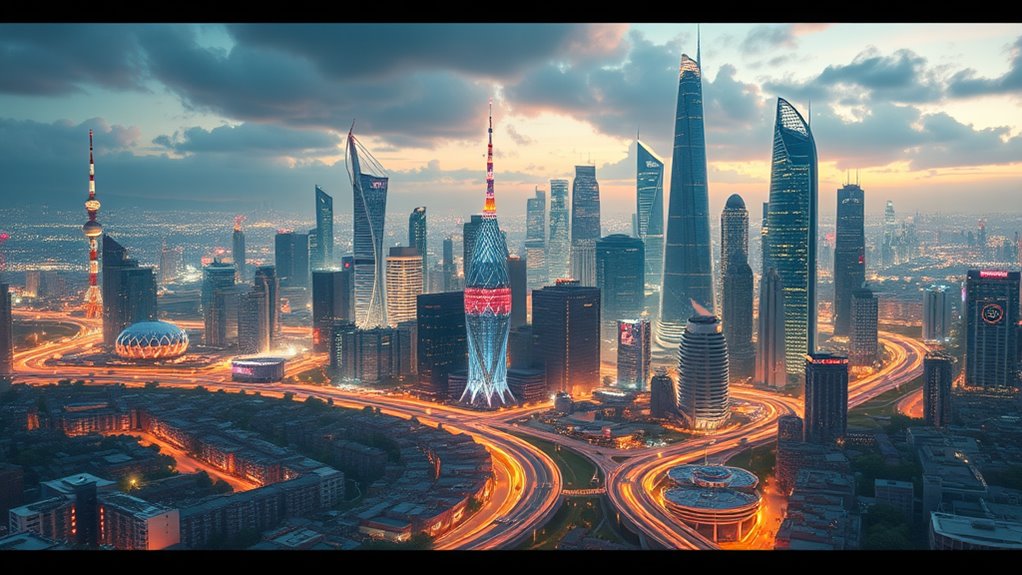
In 2050, the global economy is set to experience diverse growth rates, with an average increase of just over 3% per year from 2014 onward. Emerging economies, particularly Nigeria and Vietnam, are projected to outpace this average, potentially growing at 5% or more per annum. This significant growth will shift global power dynamics, as countries like China and India continue to rise.
By 2026, you'll see China surpass the United States in nominal GDP, remaining the largest economy until 2050. India is expected to climb to third place, with real growth averaging close to 5% during this period. Meanwhile, Indonesia and Mexico are on track to break into the top ten world economies.
Such rapid advancements among these emerging economies will reshape global economic standings, as they grow faster than their advanced counterparts, who are projected to see only 1.5-2.5% growth. The drivers of this growth stem from various factors, including an expanding labor force, enhanced human capital, and increases in physical capital stock. Favorable demographics, like higher birth rates and greater labor force participation, will bolster these emerging economies. Furthermore, poorer countries' vulnerability to climate change could pose challenges to their growth trajectories unless they develop robust coping mechanisms.
However, it's essential for these nations to implement growth-friendly policies to sustain these high rates. As you look towards 2050, keep an eye on how these shifts in economic growth will redefine global power and influence, highlighting the transformative role of emerging economies in the world.
Global GDP Distribution
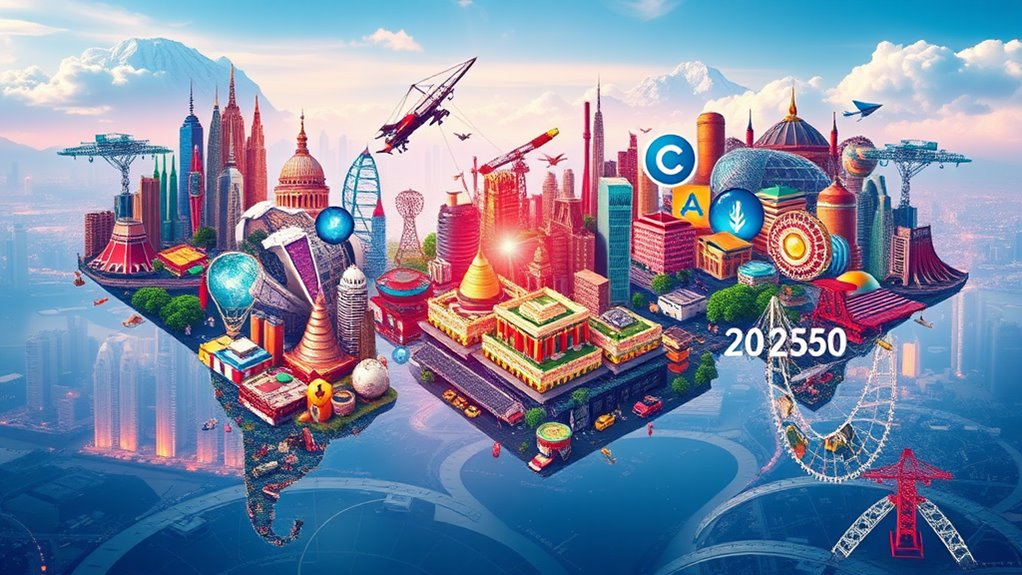
The shifting landscape of economic growth brings with it significant changes in global GDP distribution. By 2050, Asia's dominance will be undeniable, with the region projected to account for 40% of global GDP. This represents a substantial shift, as emerging markets in Asia, particularly China and India, lead the charge.
China is expected to become the world's largest economy by 2050, while India is projected to be the third-largest, experiencing annual GDP growth close to 5%. Analysts from Goldman Sachs highlight the dramatic shift in regional economic power dynamics.
You'll notice that developed markets are likely to decline in significance, dropping from over 77% of global GDP in 2000 to around 36%. This economic shift highlights the income convergence occurring between advanced economies and emerging markets.
The E7 economies, which include major players like Brazil and Indonesia, are expected to increase their share of global GDP from about 35% to nearly 50%.
Despite this growth, regional disparities will persist. Latin America is forecasted to contribute only 7% to global GDP, while Central & Eastern Europe, the Middle East, and Africa are expected to maintain a share of 17%.
As a result, the overall global economy is projected to reach around $227.9 trillion by 2050.
This landscape reflects a new world order where emerging markets play a pivotal role, driving GDP growth and reshaping economic power dynamics. You can expect that understanding these shifts will be essential for maneuvering the future global economy.
Technological Innovations Ahead
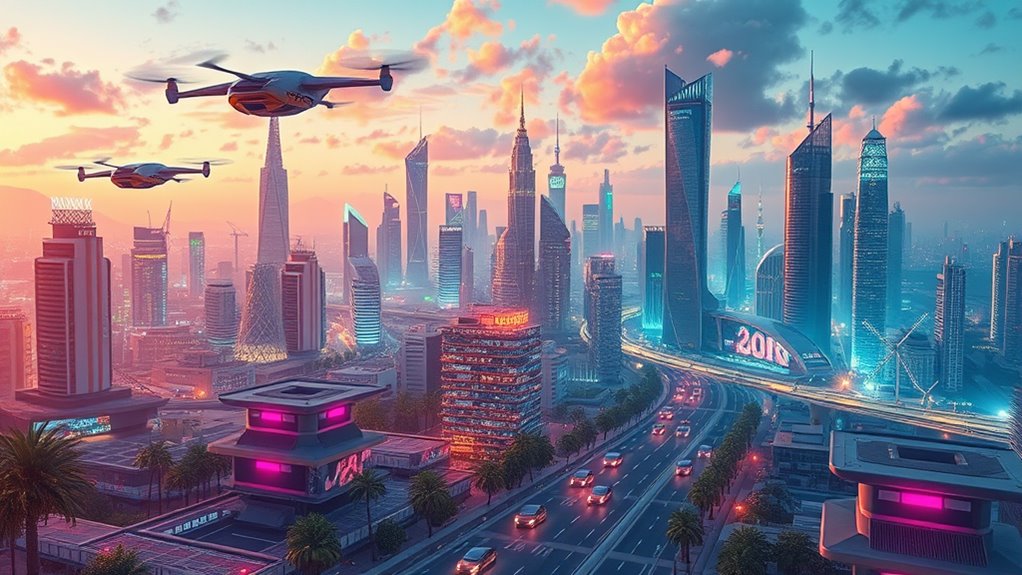
Technological innovations are set to transform life as we perceive it by 2050, driving advancements across various sectors. You'll find that human-machine collaboration will become the norm, as AI tutors provide personalized education tailored to your unique learning style.
In healthcare, biotechnology advancements will revolutionize treatment options, with regenerative medicine enabling organ regeneration and gene therapies repairing DNA damage that contributes to aging. Moreover, the wearable device market will enhance health monitoring, integrating seamlessly with your daily activities to provide real-time insights into your well-being.
Imagine a world where nanobot applications detect and treat diseases at the cellular level, greatly improving health outcomes. Optogenetics innovations may even provide new treatments for neurological disorders, making conditions like schizophrenia and Alzheimer's more manageable.
You could also expect fusion power to deliver nearly limitless clean energy, considerably reducing our reliance on fossil fuels.
As humanity pushes the boundaries of exploration, space tourism will likely become accessible, allowing you to experience lunar vacations or stay in orbital hotels.
Asteroid mining could emerge as a trillion-dollar industry, alleviating resource scarcity on Earth by providing rare materials from celestial bodies.
Furthermore, advanced propulsion technologies may cut travel times within our solar system. You might also see vacuum tube systems that enable ultra-fast ground travel between major cities, while flying cars become a practical reality for urban transportation.
In this future, technological innovations not only enhance convenience but also address some of the most pressing challenges we face, promising a life that's not just longer but also richer and more fulfilling.
The Rise of AI
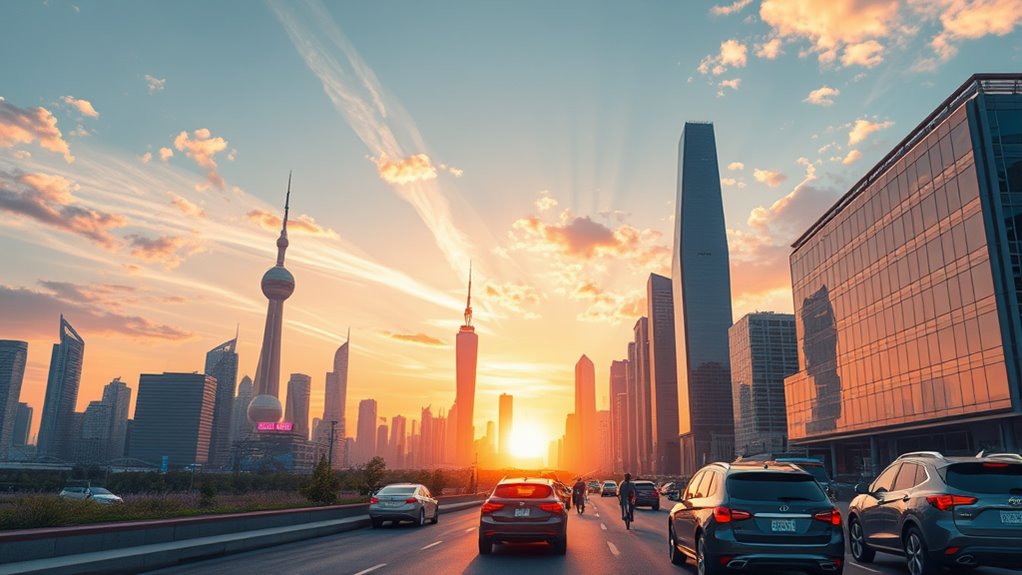
As you explore the future shaped by technological innovations, you'll notice that artificial intelligence (AI) stands at the forefront of this transformation. By 2050, AI will revolutionize various sectors, considerably impacting your daily life. Here's what to expect:
- Healthcare Revolution: AI will enable earlier disease detection, making at-home health monitoring devices commonplace. This will enhance preventive healthcare and allow for customized treatment plans. Additionally, AI will integrate genomic, health-service, and personal health data for improved accuracy in diagnosis and treatment.
- Personalized Customer Experiences: Imagine AI reading emotions in real time to tailor your shopping experience. Everyday interactions will blend human touch with AI, creating seamless engagement.
- Autonomous Transportation: Fully self-driving vehicles will dominate the roads, optimizing traffic flow and reducing congestion. This will make transportation safer and more accessible for everyone.
- Workforce and Societal Impact: While AI will automate many repetitive tasks, it'll also create new job opportunities. You may find yourself in roles focused on AI development or data science.
However, as AI continues to rise, the discussions around AI ethics and regulation will become increasingly critical.
You'll witness debates over data privacy, algorithmic bias, and the moral responsibilities of AI developers. Striking a balance between innovation and ethical considerations will be essential for a future where AI enhances our lives without compromising our values.
Get ready for a world that's not just smarter but also more conscious of the implications of its advancements.
Energy Transformation
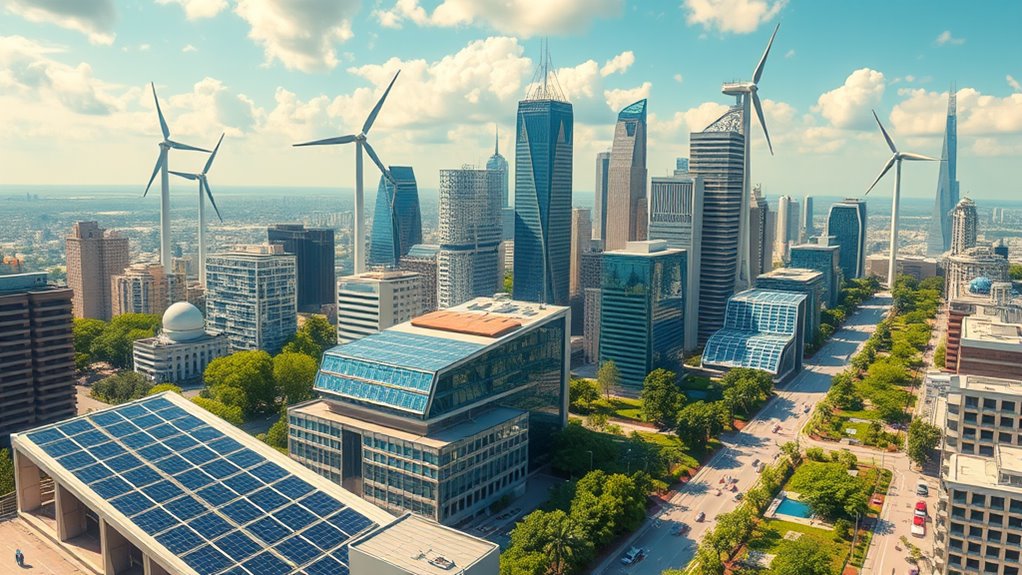
By 2050, you'll likely witness a remarkable transformation in how we produce and consume energy. Renewable technologies will dominate the energy landscape, with global electricity production expected to be 85-90% derived from sources like solar, wind, and hydropower. This shift will be driven by progressive energy policies aimed at reducing reliance on fossil fuels, which will plummet from four-fifths of total energy supply today to just over one-fifth.
Here's a snapshot of the energy mix you can expect:
| Energy Source | 2023 (%) | 2050 (%) |
|---|---|---|
| Solar PV | 5 | 33 |
| Onshore Wind | 10 | 25 |
| Hydropower | 15 | 10 |
| Offshore Wind | 2 | 10 |
| Fossil Fuels | 80 | 20 |
Despite a population surge of 2 billion, global energy demand will be about 8% lower than today, thanks to energy efficiency improvements and behavioral changes. By 2050, electricity will account for almost half of total energy consumption, with total generation increasing more than two-and-a-half times. To achieve net-zero emissions, rapid deployment of existing and emerging technologies will be essential. Innovations like low-emissions hydrogen, produced from renewable electricity, will play a pivotal role. This energy transformation will not only boost global GDP by 2.5% but also create more jobs than those lost in fossil fuel sectors, marking a significant socio-economic leap forward. Comprehensive policy frameworks will be crucial in supporting these ambitious goals.
Climate Change Strategies
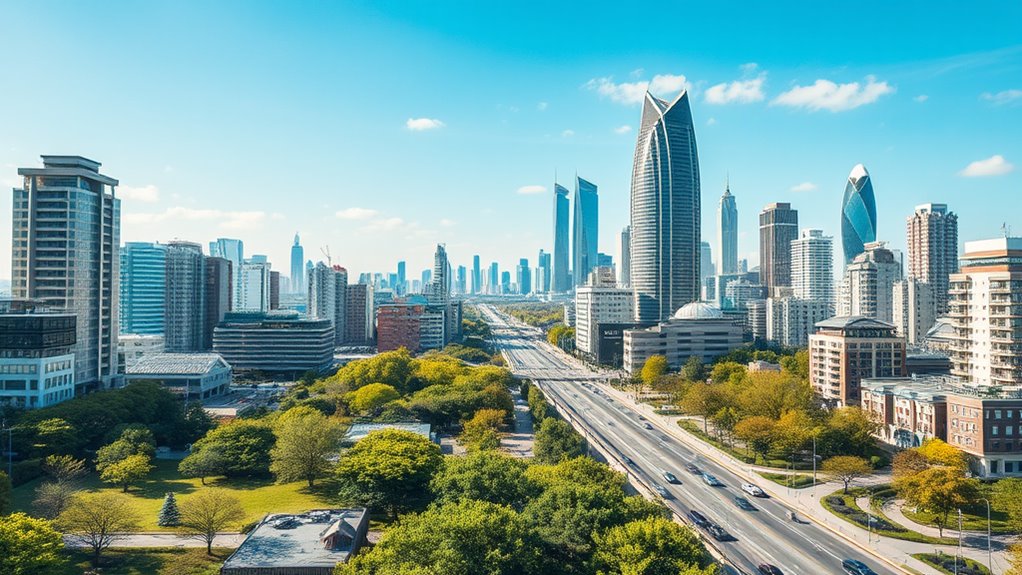
Climate change strategies are crucial for steering the world toward a sustainable future. As you navigate the complexities of climate policies, you'll find that effective strategies hinge on emission reductions, renewable technologies, and global cooperation.
To achieve net zero emissions by 2050, consider these key approaches:
- Holistic Emission Reductions: Aim for 70% reductions by 2030 across all sectors, including energy, transportation, and land use.
- Innovative Technologies: Invest in carbon capture solutions like BECCS and DACCS, alongside electrification and renewable energy, to decarbonize industries efficiently. Emphasizing decarbonized electricity supply is essential for maximizing the impact of electrification on emissions reduction.
- Transportation Sustainability: Develop multimodal transportation systems and promote compact growth patterns to minimize reliance on single-occupant vehicles.
- Climate Finance and Adaptation: Shift financial flows to support green investments and bolster resilience planning, focusing on vulnerable populations and infrastructure design.
Through these strategies, you can help mitigate the ecological impact of climate change while fostering global cooperation.
Regular monitoring and evaluation will guarantee progress aligns with benchmarks, empowering communities to adapt effectively. As you engage in resilience planning, remember that collaboration between public and private sectors is critical for promoting climate-friendly technologies.
Embracing these strategies won't only help you contribute to a more sustainable future but also enhance your community's resilience against climate-related challenges.
Space Exploration Advances
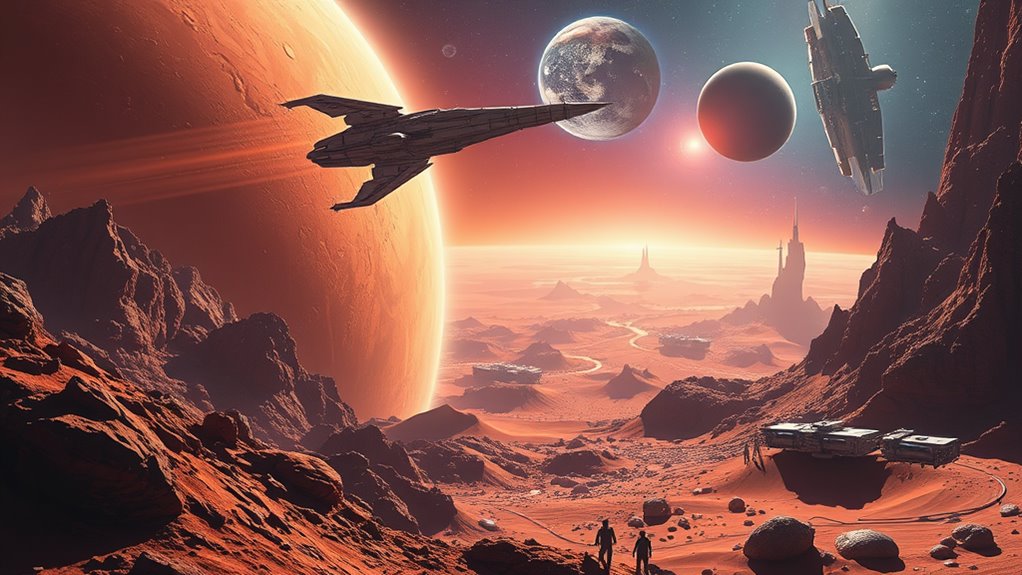
Space exploration is on the brink of a revolutionary leap forward, thanks to advanced technologies and innovative strategies.
You'll soon witness the power of quantum communications, which will enhance data transfer capabilities by utilizing faster processing speeds and higher data per photon. This will greatly improve remote sensing and communication for deep space missions.
Autonomous exploration will become a reality with self-adapting systems that monitor and adjust themselves in communications-restricted environments. These AI-driven technologies will guarantee safer navigation and better data collection during your planetary research adventures.
Meanwhile, optical technologies promise to boost data transmission rates by 10 to 100 times compared to traditional radio communications.
The future also holds exciting prospects with advanced materials, making in situ habitats feasible for sustainable living on other planets. Laser beaming will facilitate power transfer for these habitats, assuring long-term viability in space.
Enhanced space logistics will streamline operations, allowing for more efficient support of various missions and the burgeoning space economy.
As the quest for extraterrestrial discoveries intensifies, expect to see increased collaboration between commercial and international partners, all aiming to unveil the mysteries of the universe.
With the development of deep space exploration platforms like Orion and the Space Launch System, humanity is set to explore beyond our solar system.
This new era of space exploration won't only reshape our understanding of the cosmos but also elevate our global civilization through groundbreaking scientific research.
Transportation Evolution
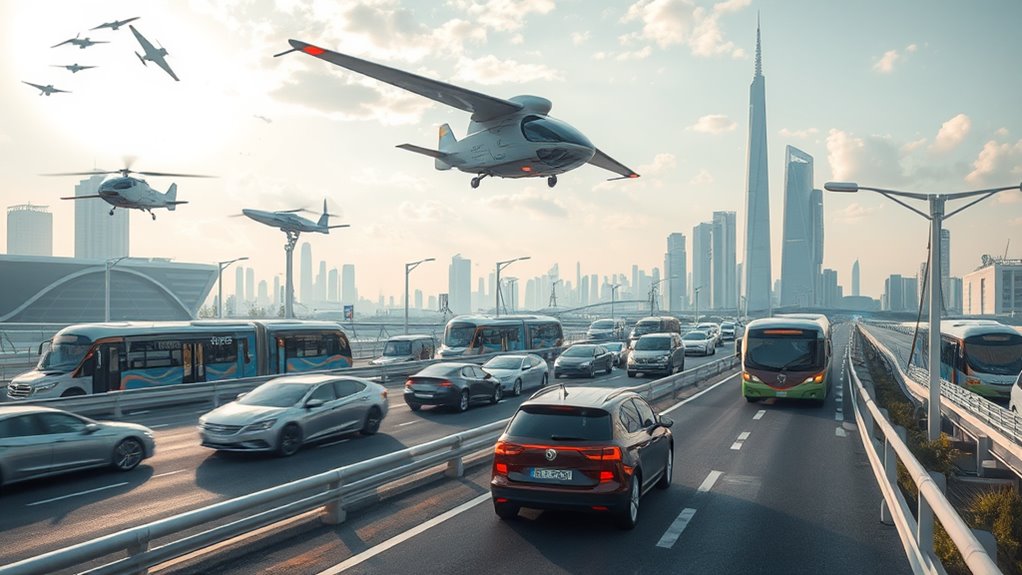
As humanity expands its reach into the cosmos, the evolution of transportation on Earth is set to transform urban living dramatically. By 2050, urban mobility will be redefined as public transport and shared transportation become the backbone of city life.
You'll witness a shift in how people navigate their environments, with several key changes:
- Public Transport Growth: Expect public transport to account for 35% of worldwide urban passenger transport, a significant rise from 14.5% in 2015.
- Shared Mobility Expansion: Over one-fifth of urban trips will be covered by shared mobility, with OECD countries leading at 24%.
- Vehicle Innovation: You'll see the emergence of friction-free vehicles powered by binary energy, reducing weight and environmental impact.
- Sustainable Choices: Walking, cycling, and transit options will be competitive for at least half of all passenger trips, promoting healthier lifestyles.
As urban passenger transport demand more than doubles, the infrastructure will adapt. Rapid transit networks will expand, prioritizing ease of movement and accessibility.
You'll find dedicated lanes for public transport, making commutes faster and reducing congestion. With the rise of zero-emission vehicles and advanced charging options, your city will become cleaner and more efficient.
In this evolving landscape, embracing shared transportation and innovative public transit won't only enhance your daily commute but also contribute to a sustainable urban future.
Health and Longevity
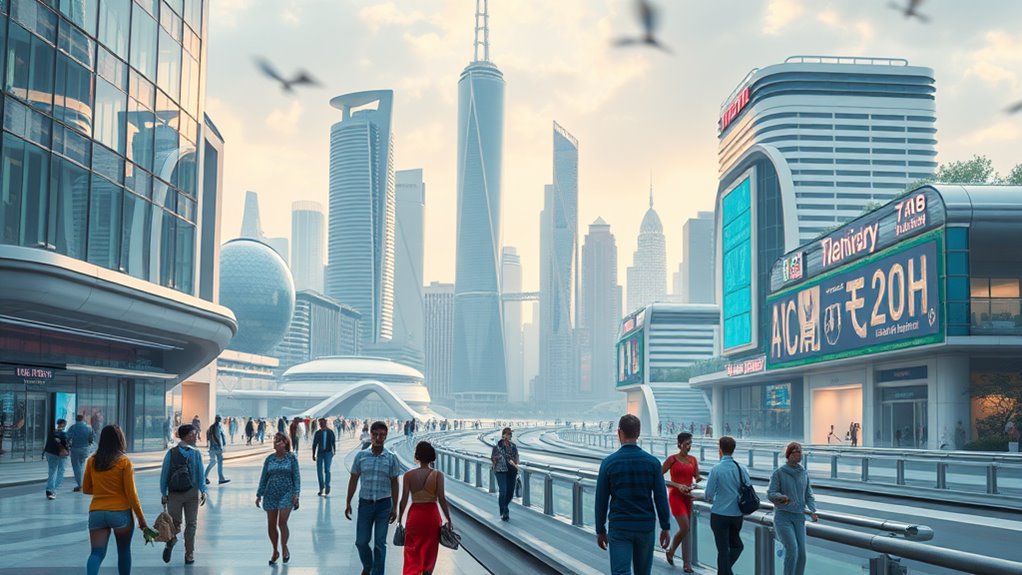
By 2050, advances in healthcare and lifestyle changes are set to dramatically enhance health and longevity across the globe. You'll see global life expectancy rise from 73.6 years to 78.1 years, with males gaining about 4.9 years and females 4.2 years. This increase is particularly noteworthy in regions like sub-Saharan Africa, where life expectancy has historically lagged.
Healthcare innovations will shift the disease burden from communicable diseases to chronic diseases, driven by an aging population and rising obesity rates. While you can expect an increase in healthy life expectancy (HALE) from 64.8 to 67.4 years, it's vital to note that many will spend more years dealing with chronic health issues. This highlights the importance of preventive measures, which can greatly improve your quality of life.
Even as health disparities persist, they're expected to lessen as public health initiatives take root globally. You'll find that effective interventions will reduce the prevalence of chronic conditions, allowing for better management of health risks.
However, be prepared for the economic implications of a longer-living population, with increased costs for programs like Medicare and Social Security.
Ultimately, the longevity trends of 2050 will reflect both the achievements in healthcare and the challenges posed by an aging population. Your engagement with preventive health strategies and advocacy for equitable healthcare access will play an important role in shaping these outcomes. The future of health and longevity hinges on your choices today.
Societal Shifts and Changes

Embracing a future shaped by societal shifts, you'll witness a profound transformation in cultural and social norms by 2050.
As technological integration and cultural evolution unfold, lifestyle changes will redefine how you engage with the world. You'll find that social interactions emphasize community engagement and mental wellbeing, leading to a more connected society.
Here are four key shifts to expect:
- Sustainable Practices: With a stronger focus on environmental awareness, you'll adopt sustainable living habits that prioritize ethical considerations and social equality.
- Work-Life Balance: Automation will give you more free time, prompting a reevaluation of work dynamics, fostering a culture where personal fulfillment takes precedence.
- Global Connectivity: Advances in communication technology will enhance global connectivity, allowing you to interact with diverse cultures, enriching your worldview and shaping your social norms.
- Community-Centric Living: You'll see a movement towards more community-oriented lifestyles, where collective efforts in problem-solving become the norm, driving social equality and inclusivity.
As you navigate this evolving landscape, expect a collective shift towards mental wellbeing, where nurturing your inner self becomes just as essential as your external achievements.
Environmental Challenges

Environmental challenges are set to escalate dramatically by 2050, impacting every aspect of life on Earth. With global greenhouse gas emissions projected to rise by 50%, you'll witness more extreme weather events and altered precipitation patterns. The loss of biodiversity is also expected to continue, driven by habitat destruction and urbanization, greatly affecting ecosystem services and human well-being.
To navigate these challenges, several strategies will be essential:
| Challenges | Strategies |
|---|---|
| Climate Change | Climate adaptation strategies |
| Biodiversity Loss | Biodiversity conservation efforts |
| Water Scarcity | Water resource management |
You'll need to embrace pollution reduction initiatives, sustainable agriculture practices, and urban resilience planning to safeguard your communities. Effective water management policies will be vital, especially with nearly 70% of the global population projected to live in cities. This shift will intensify water supply challenges and wastewater management.
Moreover, integrating renewable energy sources into daily life will help mitigate air pollution, which is expected to worsen. You can also participate in ecosystem restoration projects to enhance natural environments and improve resilience against climate impacts. By adopting these approaches, you can contribute to a healthier planet, ensuring that both current and future generations thrive despite the formidable environmental challenges ahead. Preparing now will empower you to adapt and thrive in a rapidly changing world.
Future of Work and Jobs
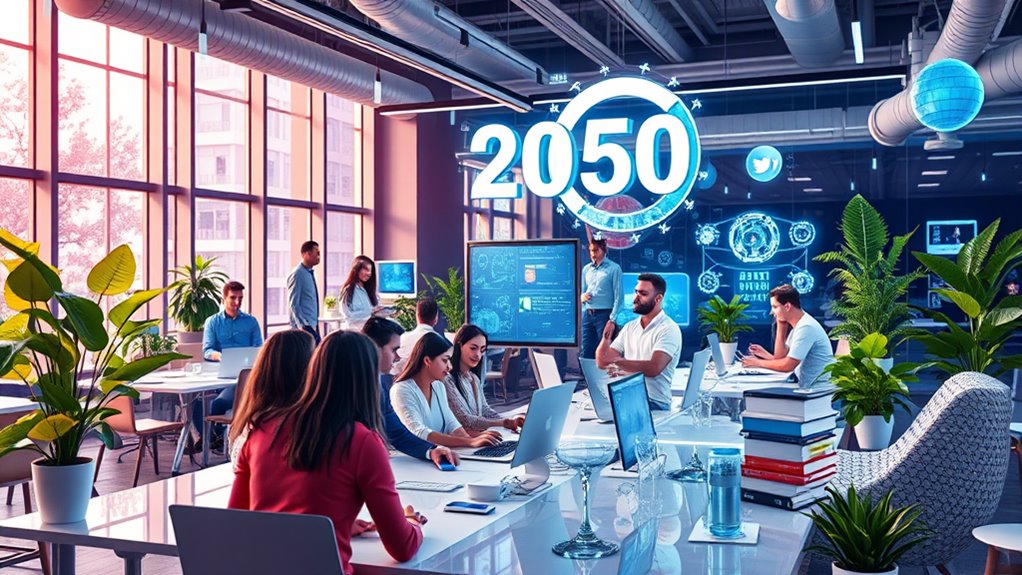
The landscape of work and jobs is evolving rapidly as technology reshapes how we live and interact. In 2050, you'll likely find yourself maneuvering a world dominated by remote work and the gig economy.
As job automation displaces millions, the demand for roles emphasizing emotional intelligence and social interaction will rise, particularly in health and caring sectors. To thrive, you'll need to embrace lifelong learning and develop strong technology fluency.
Here are four key trends shaping the future of work:
- Skills Gap: As low-skilled jobs diminish, new opportunities in creative industries will emerge. However, a significant skills gap may hinder your shift.
- Workplace Diversity: Companies will focus on building diverse teams, recognizing that varied perspectives drive innovation and adaptability.
- Job Automation: With robotics and AI integral to various sectors, you'll need to adapt and pivot towards roles that require uniquely human skills.
- Personalized Education: Training will become more tailored, equipping you with the knowledge-intensive skills necessary for the evolving job market.
In this future, the ability to adapt and continuously learn will be paramount. You'll need to cultivate emotional intelligence and social skills while staying fluent in the latest technologies.
Frequently Asked Questions
How Will Education Systems Adapt to Future Job Markets in 2050?
Education systems will adapt to future job markets by prioritizing personalized learning and remote classrooms.
You'll experience tailored courses that match your unique needs and learning styles, enhancing engagement and outcomes.
Remote classrooms will allow you to access diverse resources and collaborate with peers globally.
As industries evolve, these systems will focus on developing soft skills and technology proficiency, ensuring you're well-prepared for emerging careers in a rapidly changing job landscape.
What Will Global Population Demographics Look Like by 2050?
Imagine a vibrant tapestry, each thread representing global population demographics.
By 2050, this tapestry will show an aging population, where health disparities loom. Urban migration will shift youth demographics, creating a dynamic workforce diversity.
You'll witness an essential push for gender balance as older generations seek support from younger ones.
As Africa thrives with its youthful spirit, the world will adapt to these changes, weaving together resilience and opportunity.
How Might Cultural Norms Change in Response to Technological Advancements?
As technology advances, you'll likely see cultural norms shifting dramatically.
Virtual relationships will become more prevalent, reshaping how you connect and communicate. Your digital identity may evolve, blending online personas with real-life interactions, influencing social expectations and behaviors.
This could lead to a greater acceptance of diverse expressions of self, while also challenging traditional norms. Balancing these changes with local customs will be essential in maintaining cultural richness and authenticity.
What Ethical Concerns Arise From Advanced AI and Nanotechnology?
When it comes to advanced AI and nanotechnology, you're facing ethical concerns like AI accountability, nanotechnology ethics, and privacy implications.
You're also grappling with job displacement and the need for robust regulatory frameworks.
As you explore human enhancement, you'll need to guarantee fairness and equity in these technologies.
Balancing innovation with ethical considerations is essential, and fostering transparency will help you navigate these complex challenges effectively.
How Will Global Trade Patterns Evolve by 2050?
Global trade patterns are set to evolve considerably, driven by supply chain innovation and digital trade.
You'll see developing countries increase their export shares, reshaping market dynamics.
As manufacturing's global share declines, services will take a more prominent role.
With trade growth stabilizing, you can expect emerging economies to gain ground at the expense of established markets.
This shift will create new opportunities and challenges in how goods and services are exchanged globally.
